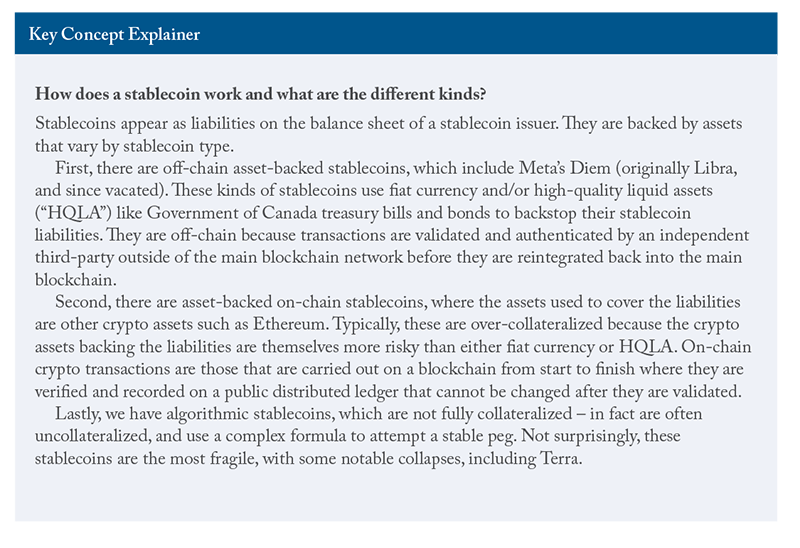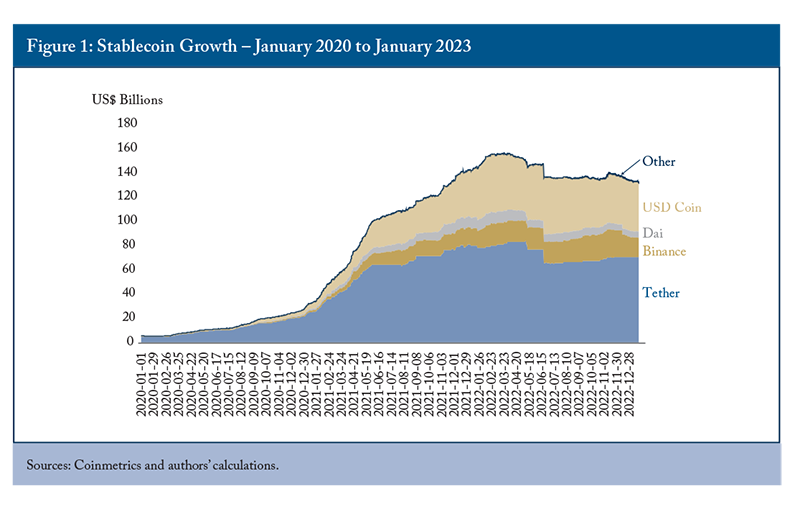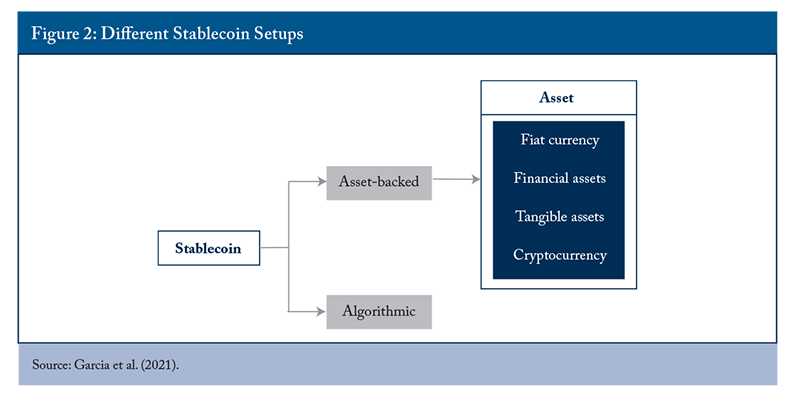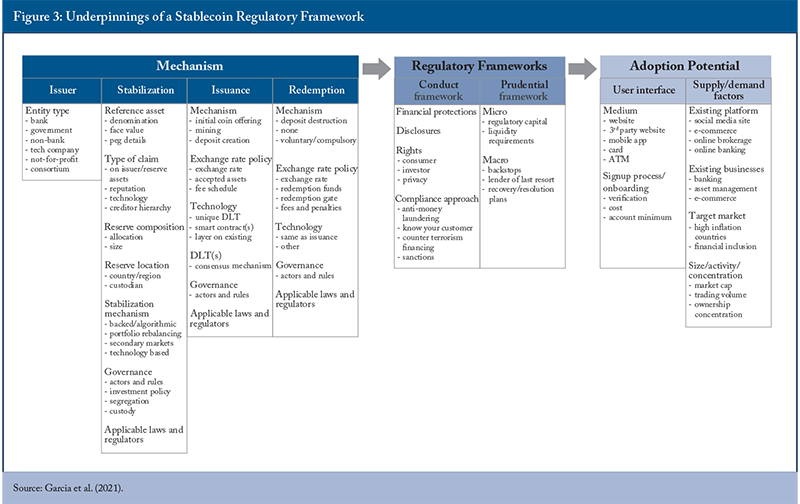The Study In Brief
Stablecoins are cryptographic (crypto) assets that are widely used in decentralized finance (DeFi) applications and crypto-asset trading strategies. Stablecoins offer the prospect that their “stable value” could potentially increase their use and desirability as a crypto medium of exchange by exploiting the benefits of blockchain technology, such as composability (integrating code from other products and DeFi applications such as lending protocols), interoperability, and instant settlement. That, in turn, offers the prospect of 24/7 availability of funds and the ability to process and settle payments instantaneously and across borders. This suggests, for example, that Canadians will be able to purchase goods and services online or send and receive money to or from friends and family members anywhere in the world instantaneously and with immediate settlement of the transaction in a safe and secure fashion.
Recent events, however, have shown that stablecoins are unlikely to reap their potential as payment vehicles unless they are properly regulated. In the absence of proper regulation it is just too tempting for some stablecoin issuers to look for ways to enhance their profits in the short run by underinvesting in needed infrastructure and controls and by backing their stablecoins with risky assets that are not sufficiently safe or liquid to hold their value in good times and bad. In some cases, like algorithmic stablecoins, they are not backed by specific assets but instead rely on computer programs that may not function as intended.
For stablecoins to flourish as widely used payment vehicles they require a proper regulatory framework. A good starting point is to adhere to the principle of “same risk, same activity, same regulation.” Another worthwhile principle is to not recreate the wheel. With this in mind, this Commentary offers some suggestions as to how stablecoins and their issuers could be regulated using the existing regulatory frameworks that are applied to retail payments-system providers and deposit-taking institutions. These existing frameworks include the Bank Act, its provincial statutory counterparts, and the relatively recent Retail Payments Activities Act. We paraphrase the Financial Stability Board’s high-level recommendations for global stablecoins – many of which apply in a domestic setting as well – and assign the legislation/recommendations/authority based on the Canadian context. These recommendations include the promotion of the following:
- A comprehensive governance framework with clear allocation of accountability for activities of the stablecoin;
- Effective risk management frameworks in place especially with regard to reserve management, operational resilience, cyber security safeguards and AML/CFT measures;
- A robust system for collecting, storing, and safeguarding data;
- Appropriate recovery and resolution plans; and
- Comprehensive and transparent information to help users understand the stabilization mechanism.
The authors thank Charles DeLand, Mawakina Bafale, Rosalie Wyonch, Steve Ambler, Ryan Clements, Thor Koeppl, John Murray, Jennifer Sloan and anonymous reviewers for comments on an earlier draft. The authors retain responsibility for any errors and the views expressed.
Introduction
The past 15 years has seen the emergence of a wide range of crypto assets like stablecoins that are based on blockchain technology.
Stablecoins are crypto assets whose values are often pegged to those of conventional assets like a fiat currency such as the US or Canadian dollar. This link to conventional currencies makes them potentially very attractive as a vehicle for making payments for goods and services. Transactions could potentially be conducted cheaply and virtually instantaneously using the underlying blockchain technology. This would be particularly beneficial for cross-border transactions, where advances in payments processing have lagged behind the innovations in domestic payment systems carried out by banks and other deposit-taking institutions for their customers. Meanwhile, stablecoins are already being used in decentralized finance (“DeFi”) – the offering of various financial instruments without traditional intermediaries, e.g., banks – to facilitate transactions between various crypto assets by serving as a medium of exchange between them.
Recent events, however, have shown that stablecoins are unlikely to reap their potential as payment vehicles unless they are properly regulated. In the absence of proper regulation it is just too tempting for some stablecoin issuers to look for ways to enhance their profits in the short run by backing their stablecoins with risky assets that are not sufficiently safe or liquid to hold their value in good times and bad. In some cases, like algorithmic stablecoins, they are not backed at all, as we discuss below.
Policymakers need to be nimble and introduce a regulatory framework that will help guide the development of a stablecoin market in Canada and give Canadians confidence that they will eventually be able to use stablecoins safely, in a way that respects their desired privacy, and is cost-effective for payment purposes. Even were stablecoin adoption rates to be low in the future, for example because a central bank digital currency makes privately issued stablecoins redundant,
We begin by explaining how privately issued stablecoins work in practice and summarize some of the shortcomings that surfaced in 2022 as crypto markets buckled in response to the global rise in interest rates and contagion from the failure of popular crypto intermediaries, e.g., FTX, and implosion of high-profile stablecoins, e.g., TerraUSD (“Terra”). We then delve into regulatory matters by first acknowledging that many stablecoins are likely to operate as crypto versions of conventional financial instruments and should be regulated as such. But given that some stablecoins aspire to serve as crypto substitutes for conventional payment vehicles, the rest of the Commentary focuses on how those stablecoins could best be regulated in that context.
Here, it is important to adhere to the principle of “same risk, same activity, same regulation.” Adherence to this principle means that one should seek to leverage existing regulatory frameworks in the oversight of stablecoins for payment purposes rather than try to reinvent the regulatory wheel from scratch. Of course, to facilitate a competitive environment, regulation needs to be tailored to the initially low risk a new entrant creates, adjusting as that new entrant’s activities become more systemic. It also needs to acknowledge that part of the attractiveness of stablecoins is the desire for increased privacy compared to traditional transactions.
Accordingly, we offer some ideas on how one could, in principle, apply the current legal framework for domestic retail payments and the laws and regulations governing deposit-taking institutions to the oversight of private stablecoin platforms operating in Canada. We conclude with some thoughts on how the Financial Stability Board’s high-level recommendations for global stablecoins can be used as a starting point for fleshing out a domestic regulatory framework.

Recent Disruptions in Stablecoin Markets Underline the Need for Proper Regulation
Stablecoins are cryptographic (crypto) assets that are widely used in DeFi applications and crypto-asset trading strategies. Some forms of stablecoins are uncollaterized, while others are pegged to the value of a reference asset, typically a fiat currency like the US or Canadian dollar, or another form of tradable asset like a bond, stock, physical commodity, or another crypto asset.
Stablecoins offer the prospect that their “stable value” could potentially increase their use and desirability as a crypto medium of exchange by exploiting the benefits of blockchain technology, such as composability (integrating code from other products and DeFi applications such as lending protocols), interoperability, and instant settlement. That, in turn, offers the prospect of 24/7 availability of funds and the ability to process and settle payments instantaneously and across borders. This suggests, for example, that Canadians will be able to purchase goods and services online or send and receive money to/from friends and family members anywhere in the world instantaneously and with immediate settlement of the transaction in a safe and secure fashion. They could do so without having to rely on sometimes risky bank wires that are costly to obtain and can take days to settle.
That said, the modernization that is currently underway in Canada’s payment system, plus the possible introduction of central bank digital currencies, may in fact deliver most of these benefits in coming years for domestic transactions without the need for privately issued stablecoins.

Despite stumbling in 2022, stablecoins have grown rapidly in recent years (see Figure 1). They now have a collective market capitalization of around US $140 billion after first emerging in 2014 and represent about 15 percent of the total crypto currency market.
While some stablecoin offerings closely resemble deposit accounts, they lack many of the features that promote public confidence in deposit accounts. For example, there is no deposit insurance, nor access to central bank liquidity facilities, making them more susceptible to runs in periods of stress. This is exacerbated by the fact that, as noted by Clements (2022a), there is currently very little regulation of stablecoins in Canada.
What factors might drive this kind of growth in stablecoins? From the Basel-based Financial Stability Board (FSB 2021): “the ability to maintain a stable value over time and under varying market conditions, the ease of use and of transfer across borders.”
Even now, the current market cap and prominence of stablecoins have already led to some notable meltdowns that have had knock-on effects on the broader financial system. In May 2022, Terra, which was supposed to track the US dollar using an algorithm, collapsed. Its sister token, “luna,” collapsed as well and became worthless. The implosion wiped out tens of billions of dollars in value. This triggered fire sales of other stablecoins and crypto assets like Bitcoin, as well as helping to fuel the declines that were taking place globally in more conventional asset prices. Moreover, it revealed widespread leverage in the crypto industry that led to the failure of Celsius (which was utilizing Terra’s Anchor protocol – heavily reliant on TerraUSD), as well as others like 3AC, Voyager, and ultimately Alameda research, which led to the failure of FTX, a Bahamas-based crypto exchange.
Those meltdowns exposed some inherent weaknesses in the platforms used to trade stablecoin assets. A major crypto trading platform, Coinbase, admitted that client crypto holdings were not in legally segregated accounts, implying investors could lose money if it failed. Another one, Binance.US was sued by a Terra investor for allegedly sidestepping federal regulations leading to disastrous consequences for investors when that stablecoin crashed. (The company denies the allegation.) Binance was also the victim of a major hacking incident in October 2022 when US $570 million was stolen from a blockchain that it operated. Then FTX collapsed and filed for bankruptcy on November 11, 2022, after an investor run that was accompanied by indications that most of the assets backing its customer accounts consisted of crypto assets that were worth far less than their reported book values, as well as allegations that the funds in customer accounts had been misused.
All of these events exposed weaknesses that are not unique to crypto platforms; they are the kind of problems that have often been seen in the past in poorly governed entities or DeFi protocols that have weak internal controls. And, again like the past, they are a good reminder of why there needs to be rigorous oversight of the governance and operational risks inherent in crypto trading platforms.
More generally, stablecoin risks include:
- financial stability risks such as the integrity of the payment system and banking;
- monetary stability risks like currency substitutions, impairing the ability of the central bank to perform monetary policy;
- user protection;
- liquidity and credit risk specific to the choice and management of a stablecoin reserve asset; and
- financial crime.
See Clements (2022a) for more. See, also, the Hong Kong Monetary Authority Discussion Paper (Hong Kong 2021), which discusses the adequacy of existing regulation in dealing with stablecoins and crypto assets writ large.
Together, these issues highlight the need for proper regulation of stablecoins. At present, there is no regulatory framework in this country for stablecoins, and none of our many regulatory authorities at the federal level have pushed for jurisdiction. From Clements (2022a): “As it currently stands, no other regulatory or supervisory body, including the Bank of Canada, the Department of Finance, the Office of the Superintendent of Financial Institutions, or the Financial Consumer Agency of Canada has formally asserted jurisdiction or instituted an overarching regulatory framework for stablecoin issuers, their distribution, operations governance, or risks.”
Canada is not unique on this front. On November 1, 2021, the President’s Working Group (PWG) on Financial Markets in the US, the Federal Deposit Insurance Corporation (FDIC) and the Office of the Comptroller of the Currency (OCC) released their report highlighting the gaps in prudential authority with respect to stablecoins intended for payment purposes. After analyzing the gaps, they recommended legislation to create a harmonized oversight framework at a federal level, and action in the meantime from regulators to use what tools they have at their disposal within their jurisdictions.
The issue, then, is how best to regulate stablecoins, in a way that combines, at a high level, the need for proper prudential oversight and consumer protection plus other safeguards without sacrificing innovation.
Types of Stablecoins: Different Asset Classes
Before we get to the regulatory framework, we need to understand what asset class(es) stablecoins fall under. To do so, it is first necessary to describe how they work, and for this, it is worthwhile thinking about the balance sheet of a potential issuer. In a vacuum, the liabilities on the balance sheet of an issuer are the stablecoins themselves. The assets that balance the stablecoin liabilities vary by stablecoin type. We borrow heavily from Clements (2022a) in defining the different kinds of stablecoins and what asset class they then fall under (see Figure 2 for a summary chart).
First, there are off-chain
Second, asset-backed on-chain stablecoins, where the assets used to cover the liabilities are other crypto assets such as Ethereum. Typically, these are over-collateralized because the crypto assets backing the liabilities are themselves more risky than either fiat currency or HQLA.
Lastly, we have algorithmic stablecoins, which are not fully collateralized – in fact are often uncollateralized – and, from Clements (2022a): “use economic incentives, arbitrage opportunities, smart contracts, and token supply modifications to attempt a stable peg.” These stablecoins are, not surprisingly, the most fragile, with many failures. Indeed, Terra was an algorithmic stablecoin, which lost its peg and led to the loss of billions of dollars.

Type of Stablecoins: Securities or Payment Instruments
With that in mind, the next question for those looking to implement a regulatory framework on stablecoins is whether they are securities or whether they are payment instruments? This matters for the design of regulatory policy, as well as which authority is best placed to conduct the oversight.
As stated in Clements, the case for stablecoins as securities is prima facie quite strong given they are mainly crypto analogues of conventional investment vehicles and are traded on platforms that are broadly similar to conventional financial exchanges. If that is true, it follows that much of the regulation for these stablecoins would fall under provincial securities regulation in Canada. Clements lays out what that would look like, and we summarize briefly here.
First, if a stablecoin is indeed a security, barring some form of exemption, a prospectus must be filed prior to distribution to the public. The prospectus would give investors the disclosure information they need (investor protection) and would provide regulators a good starting point to supervise the activities of the issuer and the trading of the stablecoins themselves. Indeed, the lawsuit against Binance.US alleges that the exchange did not disclose that Terra was a security.
Second, it stands to reason that the issuer of a stablecoin that is deemed a security may trade the stablecoin, in which case they must register as a dealer. It would then likely make sense, given the risks, to register as a dealer-member of the Investment Industry Regulatory Organization of Canada (“IIROC”). Through this membership, the stablecoin platform manager would be required to educate key staff, implement internal controls like cyber security, record keeping, and compliance, prudential and stability measures, financial reporting, know your client, segregation/safekeeping of assets, and client reporting measures.
Third, a stablecoin issuer might also operate as an investment fund like a mutual fund or an exchange-traded fund. It is up to regulators to determine this on a case-by-case basis and whether the issuer needs to also register as an advisor. Should stablecoin issuers be deemed investment fund managers, there are a variety of rules and safeguards already in place pertaining to prudential standards, reporting requirements, redemption requirements, and conflicts of interest, among others, that could be applied to them.
In our view, however, there are going to be (or already are) stablecoins whose ultimate purpose will be to act more like a payment instrument for transacting goods and services, akin to how bank deposit accounts are used today to make payments. We believe these will, at least initially, likely fall under the off-chain asset-backed stablecoin form, since those are the only kind we think are most likely to be stable enough in value in good times and bad to generate sufficient volumes of users and transactions. However, they raise the potential for macro-prudential risks, as well as the most significant consumer protection and micro-prudential risks given their size and likely network scalability. And, it is these risks that pose the greatest danger to the financial system.
In such a scenario, securities oversight is insufficient on its own in providing a comprehensive regulatory framework for the future of payment-oriented stablecoins. Such a comprehensive framework must also include a design that deals with (Clements 2022a):
- Privacy complaints;
- Safeguards for continued functioning of payment system;
- Consumer protection;
- Liability and redress;
- Interoperability;
- Ensuring technological rails that stablecoins use
The smart contracts and software running on decentralized programmable blockchains. are reliable and guard against cyber-security threats; and - Money laundering and anti-terrorism safeguards.
Below, this paper will focus on these gaps, and how they specifically apply to off-chain asset-backed stablecoins.
Regulation of Stablecoins Used For Payment Purposes Should Resemble that Imposed on Current Payment Activities
Let’s define what we would want regulation to look like specifically for off-chain asset-backed stablecoins that would be held in significant volume and serve as a popular medium of exchange in the economy. We follow Massad (2021) in much of what follows.
First, what rules/regulations do we want regarding the assets backing the stablecoins?
Here, there are two routes to consider. One option would be to allow stablecoins to be issued by nonbanking institutions or some form of special purpose vehicles (SPV) where the stablecoins would be explicitly backed by a narrow range of assets, such as a fiat currency and/or some other form of HQLA. This fiat currency/HQLA could take the form of bank deposits, Government of Canada treasury bills, and/or some other safe asset that is expected to be liquid in both good times and bad. Regulation must ensure this is the case, along with custodial safeguards for the reserve assets. Without it, recent experience has shown that there are strong incentives for these issuers to invest in riskier assets or lend the funds obtained to earn a higher return.
In previous work (see Zelmer and Kronick 2021) we discussed the option of having the Bank of Canada expand who can park settlement balances (deposits) at the central bank beyond major banks and financial institutions. If the Bank did so, stablecoin issuers could leave their assets (which would then be fiat currency) at the Bank of Canada, which would remove the theoretical counterparty risk arising from placing them with a trust company offering custodial services (though, in practice, in Canada this is quite a low risk).
A downside of this option is that it could potentially impede the supply of credit to the broader economy. Traditional lenders’ ability to continue extending credit to the economy would be impaired to the extent that those stablecoins led to a diversion of funding away from deposits in the traditional regulated banking system to stablecoins backed by a narrow range of mostly public sector-issued assets (bonds). In turn, that may require the public sector – governments, perhaps the central bank – to play the role our commercial banks/credit unions/non-bank financial intermediaries play today intermediating credit to the private sector, which may not be desirable from an economic efficiency standpoint.
A second option would allow stablecoins to be backed by a broader range of assets. This would cause their issuers to look more and more like a crypto version of a traditional regulated deposit-taking institution. In that case, it would make sense to regulate them as such and subject the stablecoin issuers to the same form of prudential regulation that is currently imposed on regulated deposit-taking institutions. The eventual direction will require government consultation with issuers to decide which route makes the most sense.
Second, how do we ensure operational resilience?
We know that part of the attractiveness of stablecoins is that they run on decentralized blockchains and smart contracts. What flaws does this software have? Where is it vulnerable to attack? Regulatory authorities must understand these issues and have a plan in place should the system run into problems – a plan where the system does not shut down or at least there is a credible path to restart it in short order. Moreover, it seems likely that in our scenario where a stablecoin is one of the main mediums of exchange, it might be too large relative to the capacity of the blockchain. At that point does the stablecoin run on a separate blockchain with distinct tokens? If it does, are the concerns over the blockchain and smart contracts multiplied? If it requires a standalone consensus mechanism or private/permissioned blockchain what kind of supervisory challenges does this entail for regulators?
Still on operational resilience, even though we have set aside a discussion of stablecoins as securities, the issue of disclosure is an important one. There should be sufficient customer disclosure so consumers are informed on several fronts. What recourse do they have, what customer information protection is present, how can their data be used, how will transactions be monitored and controlled for anti-money laundering and counter-terrorism financing purposes? We will discuss the answers to these questions below.
Lastly, what about interoperability?
There could well be multiple stablecoins in use, just as there are multiple fiat currencies and multiple financial institutions offering payment services within each fiat currency zone. We would not want difficulties moving between stablecoins and across different stablecoin platforms to interrupt the flow of economic activity. Regulators will need to sort this out both domestically and internationally as other jurisdictions proceed with country-specific stablecoins. On the domestic front, we recommend that the authorities consider how one can apply the rules and procedures governing transactions between financial institutions to crypto stablecoin payments flowing across different stablecoin systems. This is especially the case given the risk of cyber-threat in cross-chain movement.
Leveraging Regulation at Home and Aligning with Peers Abroad
Canada needs to leverage existing regulatory frameworks for domestic stablecoin transactions and work with international peers to develop regulations for cross-border transactions
The off-chain asset-backed stablecoins we focus on are seeking to become widespread mediums of exchange, at a minimum within one particular jurisdiction. As mediums of exchange looking to fill the innovative gap in payment systems, these stablecoin issuers arguably fall under the federal government’s June 2021 Retail Payments Activities Act (RPAA). Under this act, the Bank of Canada is responsible for the supervision of payment service providers (PSPs), requiring them to register with the central bank and have operational risk mitigation measures, fund safeguards, and reporting requirements. Such regulation is consistent with a recent BIS paper (Auer et al. 2021) that states: “In regulating any stablecoin, the starting point should be an appropriate registration or licensing regime, which allows for adequate information and monitoring, combined with prudential requirements in appropriate cases.”
However, regulations and formal guidance have not yet been provided for the RPAA. Furthermore, the supervisory duties of the Bank do not include some of the items in our bullet point list above, including consumer protection, liability and redress, and privacy complaints. It does not address disclosure requirements, nor does it deal with prudential risk more broadly, nor the continued functioning of the system upon failure of a payment service provider. The Department of Finance has said the criteria for regulations are coming, as well as a determination of whether stablecoins fall under the RPAA.
We believe they should be subject to the RPAA, and so proceed in the following as if they will. We provide the Department of Finance with suggested criteria around these regulations as part of a vision for a broader regulatory framework that spans the rules and regulations around the assets that back a stablecoin, operational resiliency, and interoperability.
To design our regulatory framework, we rely on parts of Garcia et al.’s (2021) framework for quantifying risk of different stablecoin arrangements (see Figure 3).

First question, who is the issuer? If it is a regulated deposit-taking institution issuing a stablecoin as a direct liability – an oft-ignored but entirely plausible scenario – then we have an entire Bank Act and its provincial statutory counterparts plus an associated regulatory and supervisory regime that can address many of the relevant issues.
Similarly, we must understand the issuance and redemption mechanics for the stablecoin. For a well-functioning economy, it should be the case that the issuer – a regulated deposit-taker or other sponsor – is ready at all times to exchange the coin one-for-one for the backing asset (fiat currency or HQLA) minus fees. It should not be the case that direct redemptions are made exclusive to a small number of counterparties. Any individual should be able to redeem a stablecoin at any time for cash or the underlying assets regardless of market conditions (normal or stress). Any move away from “at any time” leads to an increased risk that liquidity could dry up, meaning the stablecoin could lose its peg to the underlying asset. Depending on the issuer, these regulations could be issued under the authority of the Bank Act (or its provincial counterparts) or the RPAA.
We note briefly that, while there is legal uncertainty about whether a financial institution regulated provincially can issue the stablecoins we are envisioning, i.e., to be used for national and, potentially, international payments, our assumption here and the rest of the paper is that it is worth planning as if such issuance will be acceptable to the federal government and the courts.
Next, many of our bullet points above fall under one of conduct regulation or prudential regulation. Conduct regulation includes things such as complaint handling (e.g., around privacy issues) and know-your-client (KYC) rules. Prudential regulation includes things such as capital and liquidity requirements, lender of last resort functions, and recovery and resolution – i.e., ensuring the continued functioning of the payment system.
In terms of KYC rules, stablecoin issuers are money service businesses (MSBs) and as such fall under the Proceeds of Crime (Money Laundering) and Terrorist Financing Act (“PCMLTFA”). However, these regulations are only applied to intermediaries “at the point of fiat conversion and have not been applied to decentralized applications as stablecoins move through the DeFi ecosystem, or when directly transferred peer-to-peer through user-controlled digital wallets” (Clements 2022a). Much like cash, it is unclear how one can regulate the peer-to-peer from a digital wallet concern – unless those wallets were attached to accounts at a particular financial institution, a system we doubt would ever be forced on people.
The issue of complaint handling arises in other parts of the digital revolution. With respect to open banking, the UK has implemented a complaints handling process to deal with breaches of open banking standards, and has created an Open Banking Services Desk to receive complaints with a Complaints Resolution Committee to handle disputes. As one of us has argued in the past (see Koeppl and Kronick 2021) we believe the Department of Finance should set up something similar for enforcement in open banking, and, as part of the consultative process in this evolving area, its oversight could be expanded to include other areas of FinTech including stablecoins.
Around privacy, this again fits within the larger evolution required of our regulatory frameworks to deal with digitalization. Canada recently moved in this regard with the release of the Digital Charter and its 10 principles. The Charter is not law and current legislation including the Personal Information Protection and Electronic Documents Act (PIPEDA) will need to be updated. The federal government released its proposal to modernize PIPEDA – which governs personal data use by businesses in Canada. What is missing is a clear dispute resolution mechanism, for example when wrong data is shared, and a clear liability framework (again see Koeppl and Kronick 2021).
With respect to capital and liquidity requirements, here the issuer really matters. If it is a regulated deposit-taking institution issuing stablecoins directly or guaranteeing the issuing vehicle, the Office of the Superintendent of Financial Institutions (OSFI) and its provincial counterparts have clear expectations or guidance around capital and liquidity requirements based on the international Basel III Accord. The key liquidity ratios, such as the liquidity coverage ratio (LCR) and the net stable funding ratio (NSFR),
For non-bank issuing stablecoins (or stablecoins issued by regulated deposit-taking institutions via non-guaranteed SPVs), there is no guidance. This is problematic in that private sector financial services flourish when anchored to currencies issued by central banks and subject to strict regulation (see Zelmer and Kronick 2021). Canadians want to be confident that there is no risk of loss from a failure of the cryptocurrency issuer. Similarly, they would require assurances that any operational failure of the cryptocurrency platform would not expose them to risk of loss or delay in making or receiving payments.
This implies that we need to move towards regulating these non-bank issuers like deposit-taking institutions. We could go one of two routes here. First, force stablecoins to be fully backed by deposits at the Bank of Canada or other high-quality liquid assets such as Government of Canada treasury bills – which ensures stable value in good times and bad. Or, second, be more liberal in what investments stablecoins can partake in, but with the tradeoff being they must be prudentially regulated the same way a systemically important bank/financial market infrastructure is. This would include imposing capital and liquidity requirements as just discussed, and extending lender of last resort support and recovery and resolution requirements. The latter approach would also see stablecoin issuers backed by deposit insurance. This means each of OSFI, the Bank of Canada, and the Canada Deposit Insurance Corporation would all play meaningful roles in the financial stability oversight of these entities.
The regulatory structure would go beyond simply thinking in terms of the issuer, but also in terms of the activity on offer (Garcia et al. 2021). What kind of payments activity is the stablecoin supporting – retail or wholesale, domestic or international? We assume here that the provider of this service is the issuer itself. For the purposes of our off-chain, asset-backed stablecoin, we are focused on payment systems only (not, for example, on exchanges, which are regulated by provincial regulatory authorities). Domestic retail payments activities will fall under the RPAA, while wholesale will fall under the new Lynx payment system. In September 2021, the Large Value Transfer System (LVTS) was replaced by Lynx, which is operated by Payments Canada but with oversight from the Bank of Canada (see Ambler, Koeppl, and Kronick 2022 for more). As mentioned above, given that different stablecoins will operate on different platforms – the crypto equivalent to deposits held at different banks – a similar set of operating rules and systems for transfer of balances, subject to Bank oversight, will be necessary.
International payments get more complicated as they include regulated deposit-taking institutions from many different countries, messaging systems like SWIFT, different credit card networks and money transfer businesses, complex foreign exchange markets, and central banks with different arrangements. While stablecoins are meant to address some of the deficiencies of these international systems – which are slow, expensive, and opaque – multiple cryptocurrencies also create fragmentation risk. What we need are public digital platforms that connect payment systems (see Georgieva 2022 for more).
To do all this, Canada is going to have to work with other countries, likely using international forums like the various Basel-based international standard setters to further this along. Canada must be involved in the development of these platforms to ensure better communication and competition among providers, and that transactions settle seamlessly across borders, all while monitoring cross-border regulatory compliance.
The innovation and exchange features are exciting, but they require getting governance right. From Georgieva (2022): “Who will be able to access these cross-border payment platforms? Under what conditions? Who will run, manage, and oversee these platforms? What is the role of the private sector?” In addition, we add the question: would these platforms, e.g., a programmable blockchain like Ethereum, which are critical to transaction settlement, be designated as systemically important financial institutions?
The transfer system also makes us return to the question of operational resilience. We asked above a series of questions about the resilience of the blockchain system these stablecoins are likely to run on. From Schwarz 2021: “To protect against the risk that the protective cryptology underlying stablecoins may fail or be compromised, regulators might require stablecoin issuers to back up that cryptology through separate networks. The most likely failure might occur, for example, if certain validator nodes are compromised or stop operating. Regulators could protect against that risk by requiring the stablecoin issuer to maintain backup validators.”
One final thought on the transfer system. There is likely to be a hierarchy in terms of how systemic stablecoins are in a given country, and Canada could follow the European Commission in designating those at the top as such. Such a trigger would then require additional regulations including, for example, additional liquidity requirements by the relevant regulatory authority. This favours regulating the activity as opposed to simply the issuer.
A Good Starting Point: The Financial Stability Board’s High-level Recommendations for Global Stablecoins
In this section, we paraphrase the FSB’s high-level recommendations (Financial Stability Board 2021)for global stablecoins – many of which apply in a domestic setting as well – and assign the legislation/recommendation/authority based on the Canadian context.
1. Ensure a comprehensive governance framework with clear allocation of accountability for activities of the stablecoin.
a. If issuer is a bank (or federal credit union) – covered under Bank Act with OSFI as authority.
b. If issuer is a non-federal credit union – covered under provincial laws, e.g. Savings and Credit Unions Act in Quebec Act, 1988 in Quebec and the Credit Unions and Caisses Populaires Act, 2020 in Ontario, with relevant provincial prudential authority.
c. If payment service provider outside of banks/credit unions – language should be added to RPAA (borrow from Bank Act) with Bank of Canada as authority.
2. Ensure effective risk management frameworks in place especially with regard to reserve management, operational resilience, cyber security safeguards and AML/CFT measures.
a. If issuer is a bank (or federal credit union) – covered under Bank Act with OSFI as authority.
b. If issuer is a non-federal credit union – covered under provincial laws, with relevant provincial prudential authority.
c. If payment service provider outside of banks/credit unions – language should be added to RPAA (borrow from Bank Act) with Bank of Canada as authority.
3. Ensure a robust system for collecting, storing, and safeguarding data.
a. Regardless of issuer, subject to PIPEDA legislation. As mentioned above, what is missing is a clear dispute resolution mechanism, for example when wrong data is shared, and a clear liability framework.
4. Ensure appropriate recovery and resolution plans.
a. If issuer is a bank (or federal credit union) – CDIC is the regulatory authority in charge. They assist “D-SIBs by providing guidance and articulating expectations for the content and implementation of resolution plans…also responsible for reviewing and assessing these plans to ensure banks develop feasible resolution plans, and work to address any obstacles that would prevent the orderly resolution of the bank in a crisis event.”
b. If issuer is a non-federal credit union – subject to province-specific rules. For example, in Ontario, the Credit Union and Insurance Prudential (CU&IP) Recovery and Resolution team within Relationship and Risk Management (RRM) “is responsible for developing and implementing the recovery framework and resolution regime.”
c. If payment service provider outside of banks/credit unions – the Bank of Canada is responsible for recovery and resolution of financial market infrastructures, so with that experience – and as lender of last resort – they should take on this responsibility for this group. This could be made clear in the RPAA.
5. Ensure comprehensive and transparent information to understand the stabilization mechanism.
a. If issuer is a bank (or federal credit union) issuing a stablecoin as a direct or guaranteed liability of the issuer – the Bank Act as it stands covers most of the requirements but it should be updated to require institutions to publicly disclose the stabilization method. OSFI would be the relevant regulatory authority.
b. If issuer is a non-federal credit union – relevant provincial regulation should be updated much like that for the Bank Act. Authority is the provincial financial sector prudential authority.
c. If payment service provider is outside of banks/credit unions or if the stablecoin is issued by a regulated deposit-taking institution via an off balance-sheet special purpose vehicle – as above, the RPAA could put in place similar requirements. The Bank of Canada is the relevant authority.
6. Ensure legal clarity to users on the nature and enforceability of any redemption rights (including who has those rights) and the process for redemption, where applicable
a. As above, regardless of issuer it should be the case that a stablecoin can be redeemed at any time for the underlying asset regardless of market conditions (normal or stress). Any move away from “at any time” leads to an increased risk that liquidity could dry up, meaning the coin could lose its peg to the underlying asset.
b. If issuer is a bank (or federal credit union) – update Bank Act.
c. If issuer is a non-federal credit union – update relevant provincial legislation
d. If payment service provider is outside of banks/credit unions – update RPAA.
We note that the overlap between provincial and federal authorities means coordination is necessary in overseeing stablecoins used for payment purposes. The Heads of Regulatory Agencies, chaired by the Governor of the Bank of Canada, and including the Department of Finance, OSFI, the AMF in Quebec and the securities commissions in Ontario, BC, and Alberta, is likely the best body to pursue this. We would also suggest including provincial financial-sector regulators at the table for this purpose given that they oversee many important payment intermediaries in the Canadian system, some of whom could potentially offer stablecoins for payment purposes in the future.
Conclusion
Major changes are already afoot in the current payment-system plumbing that supports Canada’s financial system. While these changes are leading to significant efficiency gains in how payments are processed in Canada, the emergence of stablecoins in Canada and abroad offers the possibility of even further gains, especially with respect to cross-border payments.
Recent experience suggests, however, that stablecoins are unlikely to flourish as widely used payment vehicles unless they are backed by a proper regulatory framework. Canadians need to have confidence that any stablecoins they use for payment purposes are well designed, and can be used in good times and bad, without fear of financial loss or damage to their interests as consumers.
In developing a proper regulatory framework, a good starting point is to adhere to the principle that stablecoins used for payment purposes should be subject to the same type of oversight that is imposed on conventional payment activities. Another worthwhile principle to adhere to in this respect is to not recreate the wheel. With this in mind, we offer some suggestions as to how stablecoins and their issuers can be regulated using the existing regulatory frameworks that are applied to retail payments-system providers and deposit-taking institutions. Coordination between the various policymaking and regulatory bodies will be crucial to bringing these suggestions together in a cohesive regulatory framework.
Canada has often been a leader in the past in the development of efficient payment systems that have underpinned our strong financial system and the performance of our economy more generally. Privately issued stablecoins based on new blockchain technology offer the promise of major gains in the processing of payments, especially for those that cross national borders. We need to move quickly in developing and implementing a domestic regulatory framework for these transactions if we wish to set the stage for a flourishing crypto-based payment system to emerge in Canada, if the public wishes to use it, and also position us to punch above our weight in influencing the development of the oversight framework that will ultimately govern cross-border transactions.
References
Ambler, Steve, Thorsten V. Koeppl, and Jeremy Kronick. 2022. Quo Vadis? The Future of the Bank of Canada’s Balance Sheet. Commentary 631. Toronto: C.D. Howe Institute. November.
Arner, Douglas, Raphael Auer, and Jon Frost. 2020. “Stablecoins: risks, potential and regulation.” BIS Working Papers No. 905. November.
Clements, Ryan. 2021. “Built to Fail: The Inherent Fragility of Algorithmic Stablecoins.” The Wake Forest Law Review. Online 131. October.
____________. 2022a. “Defining the Regulatory Perimeter for Stablecoins in Canada.” Canadian Business Law Journal. 66: 201.
____________. 2022b. “Cryptocurrency: Challenges to Conventional Governance of Financial Transactions.” Commissioned Paper. Public Order Emergency Commission. September.
Financial Stability Board. 2021. Regulation, Supervision and Oversight of “Global Stablecoin” Arrangements. October.
Garcia, Alejandro, Bena Lands, and Dennis Yanchus. 2021. “Stablecoin Assessment Framework.” Bank of Canada Staff Discussion Paper 2021-6.
Georgieva Kristalina. 2022. Confronting Fragmentation: How to Modernize the International Payment System. International Monetary Fund Speech. May.
Hong Kong Monetary Authority. 2021. “Discussion Paper on Crypto-assets and Stablecoins.” January.
International Monetary Fund. 2020. “Canada Financial Sector Assessment Program: Technical Note – Bank Resolution and Crisis Management.” January.
Koeppl, Thorsten V., and Jeremy Kronick. 2020. Open Banking in Canada – The Path to Implementation. Commentary 579. Toronto: C.D. Howe Institute. September.
Kronick, Jeremy. “The Unintended Consequences of Bail-in.” Intelligence Memo. Toronto: C.D. Howe Institute. December 8.







